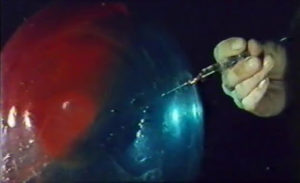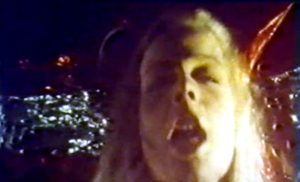 This is a piece I wrote for Electric Sheep Magazine in 2014.
This is a piece I wrote for Electric Sheep Magazine in 2014.
A rambling title is often a reflection of a rambling narrative; it can indicate either ambition or indecisiveness. There is a reason these long-winded titles proliferated in the late 60s and early 70s – things like William Klein’s Who Are You, Polly Magoo? (1966), Peter Whitehead’s Tonite Let’s All Make Love in London (1967), Anthony Newley’s Can Heironymus Merkin Ever Forget Mercy Humppe and Find True Happiness? (1969), Ulu Grosbard’s Who Is Harry Kellerman and Why Is He Saying Those Terrible Things about Me? (1971) and Paul Williams’s Dealing: Or the Berkeley-to-Boston Forty-Brick Lost-Bag Blues (1972), not to mention a slew of Italian giallo films. All of these films have a zig-zagging sense of aimlessness and leisure, a cultural urge to ‘be here now’ that can be alternately transcendent or masturbatory, depending on the film (or the viewer). Underground and commercial cinema alike at this time were quilted with countercultural concerns, sensibilities, techniques and aesthetics – the writing of the Beats, the mobilization of protest movements, the ubiquity of pop stars, the street use of LSD, Timothy Leary’s urge to tune in, turn on, drop out (it’s also telling that many of these film titles come in the form of a question). The mainstream increasingly appropriated the signifiers of the avant-garde in an attempt to woo an exploding youth market (as well as that demographic keen to hang on to their youth for dear life), and in this climate, a title like Microscopic Liquid Subway to Oblivion was likely enough to sell a producer on a project. By the 1970s, when even squares lined up to see Deep Throat in the cinema, it was often hard to tell who was the real deal and who was exploiting the convenience of a double standard. As J. Hoberman and Jonathan Rosenbaum said in their book Midnight Movies (1983), ‘the counterculture cash-in peaked in 1970’, and the Italian production Microscopic Liquid Subway to Oblivion is one of many films to tap into that zeitgeist.
 But for a film whose title references a narcotic trip, it is surprisingly bereft of any real lysergic sensibility; the opening credits (cropped as they were, from a Greek-subtitled ETC bootleg) are among its few moments of visual experimentation, with psychedelic colour splashes, jarring sonic shifts and fish-eyed shots of Eurotrash starlet Ewa Aulin grooving in slow motion to the tone-deaf eponymous theme tune, sung by Ronnie Jones and penned by director John Shadow – a mysterious figure in the cult film pantheon.
But for a film whose title references a narcotic trip, it is surprisingly bereft of any real lysergic sensibility; the opening credits (cropped as they were, from a Greek-subtitled ETC bootleg) are among its few moments of visual experimentation, with psychedelic colour splashes, jarring sonic shifts and fish-eyed shots of Eurotrash starlet Ewa Aulin grooving in slow motion to the tone-deaf eponymous theme tune, sung by Ronnie Jones and penned by director John Shadow – a mysterious figure in the cult film pantheon.
Repeated use of oppressive lighting underscores the predatory nature of John, a tenured college professor (Alex Rebar, later to star in The Incredible Melting Man) who feels his school’s reputation is threatened by rampant drug use among its students, namely the delinquent heroin addict Billy (Italian horror staple Carlo De Mejo, almost unrecognizable without his beard). After a fellow teacher leaps to his death, supposedly under the influence of drugs, John enlists the help of nerdy student Henry (Eugene Pomeroy) to lure Billy into isolation at the professor’s Italian villa with a plan to dry him out. John’s young, subservient wife Elizabeth (Ewa Aulin) is not too keen on sharing her vacation with a heroin addict, but the professor reprimands her for being selfish when ‘that boy’s under the grip of a deadly neurosis!’ John relishes his privileged position as the boy’s saviour, to such an extent that he’s willing to subject his impressionable wife to the druggie’s charms; it only has to be merely suggested to her that she try a shot, and she’s immediately a sweaty, shivering addict. So now John and Henry have two addicts on their hands.
The professor uses every opportunity to torment Billy, and also manipulates Henry, appealing to his loyalty by referring to him as ‘a peer’. But eventually the tables are turned on John as the doped-up Billy mocks his masculinity: ‘Elizabeth, have you ever seen your husband’s penis?’ Under the influence of freshly administered heroin, Elizabeth is liberated, theatrical and aggressive. But while in her stateside breakout film Candy (1968) Aulin’s vacuity was perfectly suited to the part of angelic naïf, here it just seems an embarrassing put-on. The stoic professor’s motto – ‘no emotion!’ – will be tested throughout the film as his experiment veers out of control.
Microscopic Liquid Subway to Oblivion posits itself as a counterculture film, thinking that its parade of non-sequiturs somehow aligns it with the existential kookiness of Bob Rafelson’s Head (1968), the swingin’ free love space-out of Joe Massot’s Wonderwall (1968), the inverted suspense of Antonioni’s Blow-Up (1966) and Volker Schlöndorff’s A Degree of Murder (1967) as well as various AIP youth-in-revolt and drug films. Unfortunately it succeeds at assimilating none of the qualities that make these films stand out, and instead seems a schizophrenic, somewhat inept cadavre exquis. There is a great sense of temporal dislocation (which is not helped by an unexplored subplot involving some hippies camped out nearby). But as Jonny Redman of cult film site lovelockandload.com has suggested, there is the distinct impression that the film was unfinished.
Aside from its tongue-twisting title, one thing that keeps Microscopic Liquid Subway to Oblivion in the history books is the ongoing mystery about who directed it, and where (and if) it was ever widely released. Although it is credited to John W. Shadow on screen, some have maintained that this is a pseudonym of producer Roberto Loyola, whose eclectic roster also included Sergio Corbucci’s goofy Western Sonny and Jed, Mario Bava’s claustrophobic crime film Rabid Dogs, and the Decamerotic sex comedy Canterbury No 2. The latter (which also stars Microscopic Liquid Subway to Oblivion’s Alex Rebar) is credited to director John Shadow, but it has been argued that the name was a pseudonym for Aristide Massacesi, best known as Joe D’Amato. The name John Shadow resurfaces again as the screenwriter of Juan Piquer Simón’s Pieces, also long assumed to be Joe D’Amato.
But a look through the newspapers surrounding Ewa Aulin’s brief fling with fame following the sensational Candy reveals John Shadow to be not only a real person, but married to Aulin from approximately 1968 to 1972. Actor Eugene Pomeroy, one of many young British expats working in Italian cinema at the time, remembers calling the director ‘John’ on set, although he too was confused about whether this John Shadow and producer Roberto Loyola were the same person . Without being able to pinpoint who John Shadow was, it is difficult to discern what may have happened to the film – which appears to have only ever been released on Greek video – and why the narrative’s many tangents are left dangling.
Despite featuring no murder set-pieces, the film nevertheless wound up in the giallo files by association; the giallo tended to be a playpen for all manner of visual and moral excess, and not only was drug abuse one of its staples, but Aulin had appeared in Giulio Questi’s head-scratching 1968 art-giallo Death Laid an Egg (and would later appear in Romolo Guerrieri’s 1971 The Double). Ultimately, the film defies categorization, living on only through its superficial ties to other various sensational subgenres, refusing to follow through on any single element – drugs, music, sexual liberation – that would make its content live up to the countercultural promise of its spectacular title.
